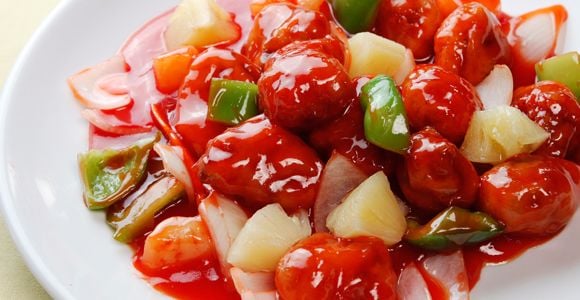Traditional Chinese food varies significantly depending on what part of China you visit. Chinese food is not inherently unhealthy, but there is definitely a plethora of unhealthy options on the menu. Americanized Chinese food is quite different from the traditional cuisines of China. Oftentimes, many of American-Chinese dishes are based on fried foods with heavy sauces high in fat, sodium and sugar.
1. Crab Rangoon
Think about it. It's cream cheese and a tiny amount of crab meat (is there even any crab in there?) that is breaded and deep fried and then served with a sugar-laden sweet and sour sauce. This fan favorite is full of fat. Avoid this appetizer if you want to avoid going up a pant size.
2. Barbeque Spare Ribs
Although these hunks of fatty meat are somehow considered an "appetizer," they contain more than 600 calories per serving and more than 66 percent of your day's recommended saturated fat intake.
3. Fried Egg Rolls
A single fried egg roll can pack between 200 and 300 calories, depending on what is stuffed inside of it. This staple appetizer can easily catapult your meal into a calorie catastrophe, especially if you eat more than one egg roll.
4. Fried Rice
Huge portions of fried refined grains--yuck! One dish of fried rice houses about 75 percent of your daily caloric needs. Considering that one cup of cooked rice contains about 216 calories, and most servings of fried rice are about four to five cups of rice that are then fried in oil and generally have some sort of meat added--oftentimes fatty pork or beef--it's easy to see how the calorie count climbs. Additionally, fried rice is usually made from nutritionally-void white rice, as opposed to more nutritious brown rice, and it likely contains only a tiny amount of vegetables, if any.
5. Lo Mein
It clocks in at over 1,400 calories thanks to oil-covered noodles and fatty marbled meats. Plus, the seasoning used in this dish contains more sodium than you need in an entire day. Much like fried rice, lo mein is mainly low in beneficial nutrients, consisting mostly of large amounts of refined carbs, excessive oil and fatty cuts of meat that are added.
6. Chow Fun
Just like the lo mein, this dish is mainly fried noodles and not-so-lean meats. If you eat the entire dish, expect to take in more than 1,200 calories and more than a day's worth of sodium. Chow fun = not so fun for your waistline!
7. Sweet and Sour Chicken
Even though chicken is a lean protein, the calorie count shoots way up when you batter and deep fry it and then drown it in a sugary sauce. This dish's calorie count skyrockets to over 1,000 calories due to all of that oil-soaked batter and overly-sweetened sauce.
8. General Tso's Chicken
Much like the sweet and sour chicken, this dish is loaded with fat and calories because it's breaded, deep-fried and swimming in a heavy sauce. One serving of this popular dish racks up about 1,300 calories and more than half your day's allowance of heart-clogging saturated fat.
The Bottom Line
You can certainly find healthy options at Chinese restaurants. Opt for stir-fry dishes that are mainly vegetables rather than rice or noodles. Avoid battered, fried meats soaked in sauce. Split a meal with a friend or get half of it "to-go" to make for a more realistic portion size. If you eat rice, request brown rice rather than white rice and stick to a one-cup serving.
Kari Hartel, RD, LD is a Registered, Licensed Dietitian and freelance writer based out of St. Louis, MO. Kari is passionate about nutrition education and the prevention of chronic disease through a healthy diet and active lifestyle. Kari holds a Bachelor of Science in Dietetics from Southeast Missouri State University and is committed to helping people lead healthy lives. She completed a yearlong dietetic internship at OSF St. Francis Medical Center in Peoria, IL, where she worked with a multitude of clients and patients with complicated diagnoses. She planned, marketed, and implemented nutrition education programs and cooking demonstrations for the general public as well as for special populations, including patients with cancer, heart disease, diabetes, Alzheimer's disease, obesity, and school-aged children.




